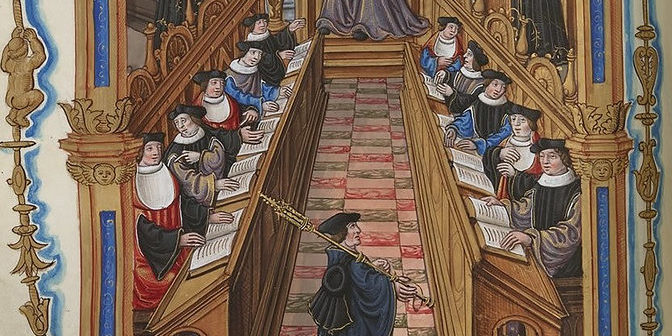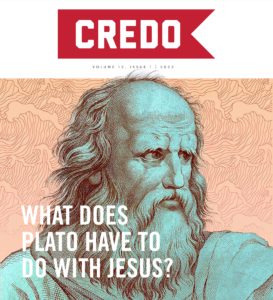
What exactly is Protestant Scholasticism and why does it matter?
The latest issue of C redo Magazine focuses on Christian Platonism. The following is one of the issue’s featured articles by Jordan B. Cooper. Dr. Cooper is an ordained Lutheran pastor, an adjunct professor of Systematic Theology, the Executive Director of Just and Sinner, and the President of the American Lutheran Theological Seminary.
redo Magazine focuses on Christian Platonism. The following is one of the issue’s featured articles by Jordan B. Cooper. Dr. Cooper is an ordained Lutheran pastor, an adjunct professor of Systematic Theology, the Executive Director of Just and Sinner, and the President of the American Lutheran Theological Seminary.
The term “scholasticism” is somewhat difficult to define. Church historians often use it to identify a particular movement in the medieval church from St. Anselm until the age of the Renaissance (about 1050 AD to 1500 AD). With such a definition, there is no room for a Protestant scholasticism at all, as the era of the Reformation arises after the decline of the scholastic movements of the middle ages. When we use the term “Protestant scholasticism,” then, it is important to identify precisely what it is that such a term means.
Like its medieval counterpart, “Protestant scholasticism” can be used to identify a group of theologians writing in a historical period—particularly, the seventeenth century. However, the things usually used to identify a thinker as a Protestant scholastic in this era all extend far beyond the seventeenth century. There was a revival of the terminology and systems of this age in nineteenth century Lutheranism, for example, with writers such as Conrad Emil Lindberg (1852-1930) and Revere Franklin Weidner (1851-1915), who both produced dogmatic texts which could rightly be called “scholastic.” Today, many writers (myself included) have begun to self-identify as Protestant scholastics. Thus, while recognizing the roots of Protestant scholasticism in the second and third generations of Protestantism, we can define this movement more broadly by some of its foundational ideological and methodological principles. With this in mind, it is incumbent upon us to ask: what are these key features of a Protestant scholastic theology?Despite what some assume when hearing about the term “scholasticism,” those of us who are Protestant scholastics are not standing with one foot in the Reformation and the other in Rome. Click To Tweet
With the identifier “Protestant,” we mean to identify adherence to the central principles of the sixteenth-century Reformation: sola fide, sola Scriptura, and sola gratia. With all of the areas of overlap between Protestant and Roman Catholic scholastic movements, it is essential to identify these distinctives. Despite what some assume when hearing about the term “scholasticism,” those of us who are Protestant scholastics are not standing with one foot in the Reformation and the other in Rome. Protestant scholasticism grows out of a commitment to the unique authority of Scripture, and the doctrine of the sinner’s justification through faith alone.
Adherence to these ideas alone does not make one a scholastic of course, as there are plenty of Protestants who would shudder at the thought of identifying with such a label. The uniqueness of the Protestants who are called scholastics is mostly in three areas: first is the focus of clarity of terminology and extensive presentation of arguments in favor of doctrinal distinctives, along with refutation of opposing views. Second, the scholastics often discuss the relationship between faith and reason (or this could be characterized as the relationship between theology and philosophy). Third, the Protestant scholastics are philosophical realists. Though much could be (and has been) said about the other two points, this article addresses only the third.
The Protestant Adoption of Realism
Before moving onto the details, realism itself should be defined for the uninitiated in philosophical terminology. In short, realism is the belief that when we encounter the world through our experience, we come into contact with real essences that are grasped by the mind. For example, I have a tree outside of my window. As I see that object, my mind identifies this with the category “tree.” The realist says that “tree” is a real category that has an essence that is independent of my own intellect and subjective experience. I can understand the tree as it actually is, since the object shares in the essence of “treeness” and I can mentally grasp the concept of “tree.”Realism is the belief that when we encounter the world through our experience, we come into contact with real essences that are grasped by the mind. Click To Tweet
The opposite of realism is known as nominalism. This ideology is founded upon the notion that essences are not actually real at all. The words that we use to signify are creations of either human language or of the mind. Thus, when I see the object outside of my window, there is nothing inherent within it that makes it a “tree.” Rather, humans have simply chosen to use the category of tree to identify a number of separate objects that have similar characteristics. In this view, our minds do not simply receive that which is outside of us, but we instead shape how the world is viewed by way of subjective categories.

